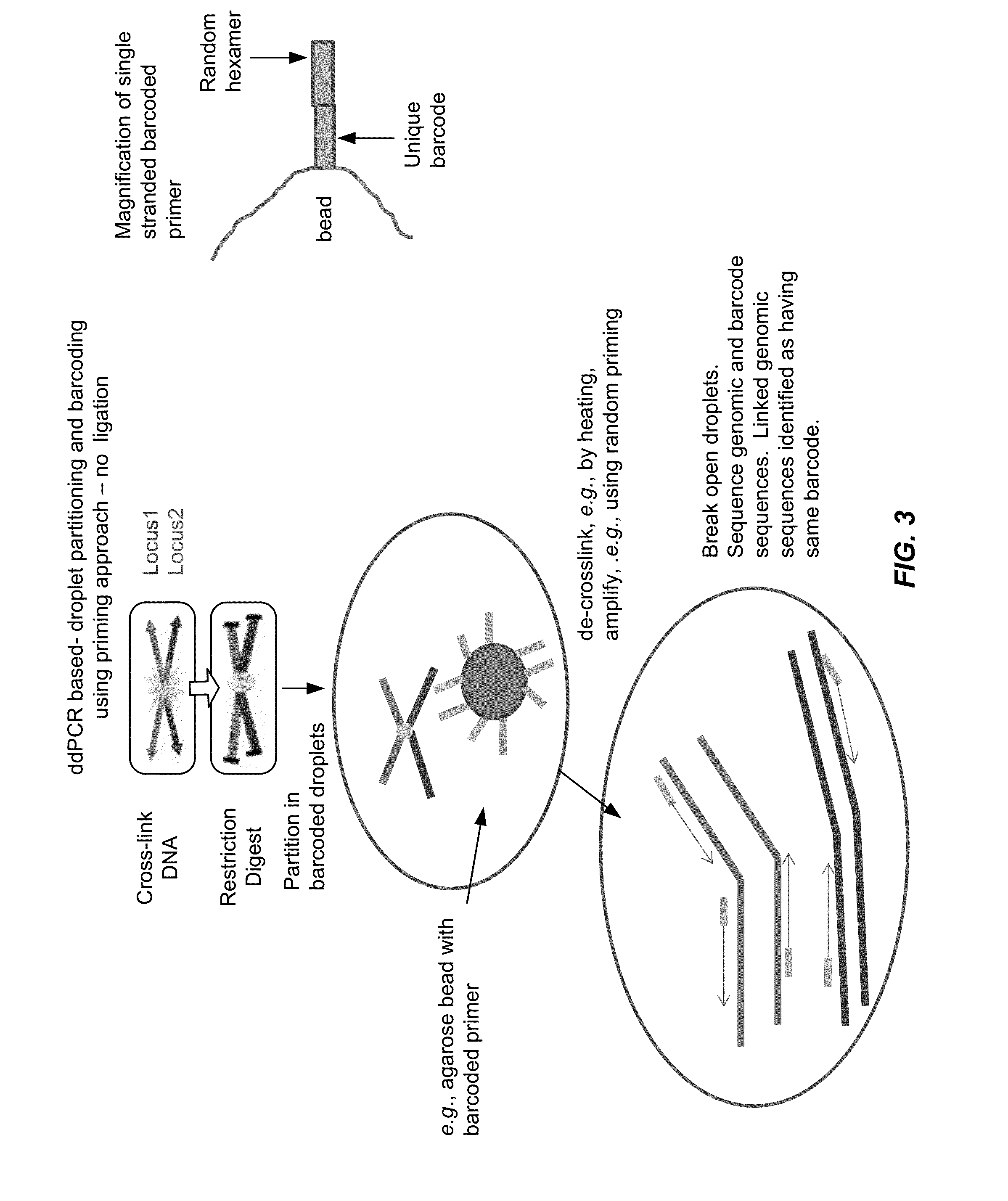Chromosome conformation capture in partitions
a technology of chromosome conformation and partition, which is applied in the direction of library member identification, nucleotide libraries, biochemistry apparatus and processes, etc., can solve the problems of little information in the library of molecules, and achieve the effect of improving efficiency, completion or fidelity of the ligation step
- Summary
- Abstract
- Description
- Claims
- Application Information
AI Technical Summary
Benefits of technology
Problems solved by technology
Method used
Image
Examples
example 1
[0111]Chromatin is cross-linked using standard protocols and digested with a restriction enzyme. The resulting cross-linked DNA fragments are then diluted and partitioned into droplets containing a ddPCR assay reaction mix. Cross-linked fragments end up in same droplets. DNA is optionally reverse cross-linked in the initial denaturation step during ddPCR. Double positive droplets (i.e., droplets testing positive for two different DNA sequence elements) indicate that DNA sequence elements were cross-linked and thus physically connected in the chromatin state inside the cell. Thus, this method does not require ligation of cross-linked DNA before reverse cross-linking and eliminates artifacts caused by this ligation step. See, FIGS. 1-4.
example 2
[0112]Chromatin is cross-linked using standard protocols and digested with a restriction enzyme. The resulting cross-linked DNA fragments are then diluted and partitioned into droplets containing a barcode. Cross-linked fragments end up in same droplets. Cross-linked DNA fragments are conjugated via ligation or polymerization to the barcodes. DNA is optionally reverse cross-linked. Droplets are combined, and the barcoded DNA is sequenced and / or amplified. DNA sequence elements having the same barcode are identified as having been physically linked during the cross-linking (e.g., in the chromatin state inside the cell). See, FIGS. 1-4.
example 3
[0113]Chromatin is cross-linked using standard protocols and digested with a restriction enzyme. The resulting cross-linked DNA fragments are then diluted and partitioned into droplets. Cross-linked fragments end up in same droplets. Cross-linked DNA fragments are optionally reverse cross-linked by heating, injection of protease or high salt buffer, or a combination thereof. Barcoding reagents are injected into the droplets. Barcodes are conjugated to the DNA fragments via ligation or polymerization. Droplets are combined, and the barcoded DNA is sequenced and / or amplified. DNA sequence elements having the same barcode are identified as having been physically linked during the cross-linking (e.g., in the chromatin state inside the cell). See, FIG. 4, subsections 1-4, and 5b)-7b). Alternatively, ddPCR reagents are injected into the droplets and ddPCR performed. Double positive droplets (i.e., droplets testing positive for two different DNA sequence elements) indicate that DNA sequenc...
PUM
| Property | Measurement | Unit |
|---|---|---|
| Volume | aaaaa | aaaaa |
| Volume | aaaaa | aaaaa |
| Volume | aaaaa | aaaaa |
Abstract
Description
Claims
Application Information
 Login to View More
Login to View More - R&D
- Intellectual Property
- Life Sciences
- Materials
- Tech Scout
- Unparalleled Data Quality
- Higher Quality Content
- 60% Fewer Hallucinations
Browse by: Latest US Patents, China's latest patents, Technical Efficacy Thesaurus, Application Domain, Technology Topic, Popular Technical Reports.
© 2025 PatSnap. All rights reserved.Legal|Privacy policy|Modern Slavery Act Transparency Statement|Sitemap|About US| Contact US: help@patsnap.com



